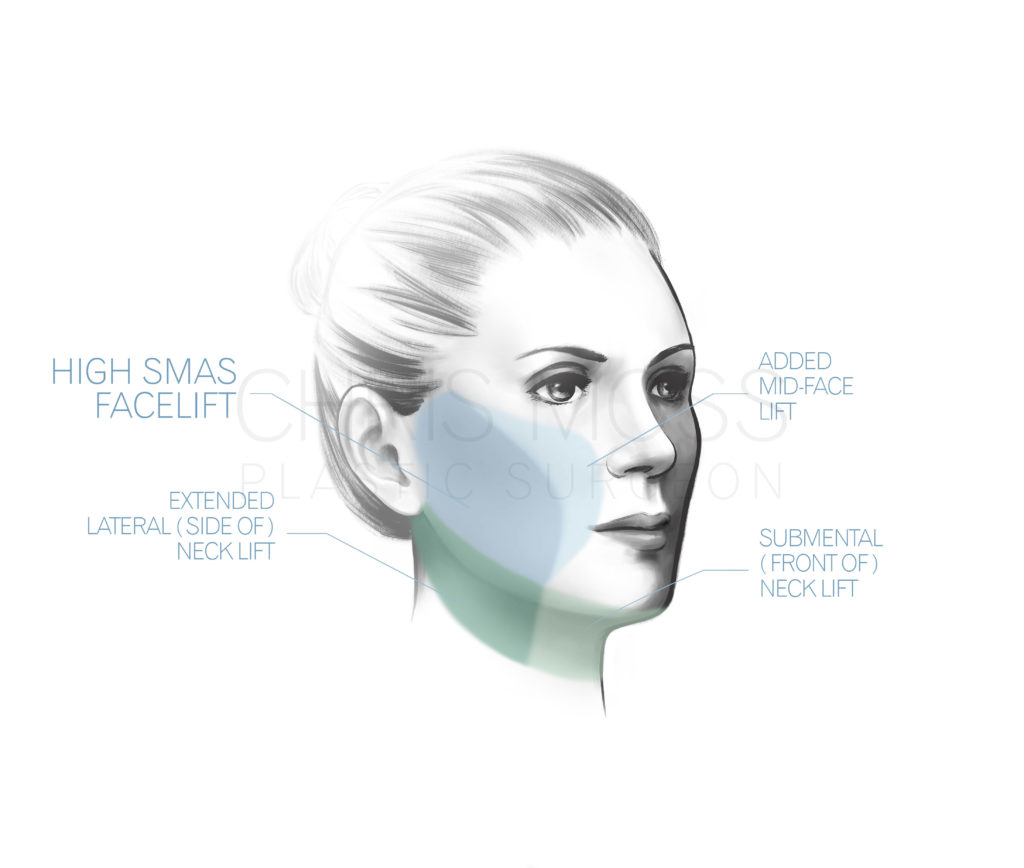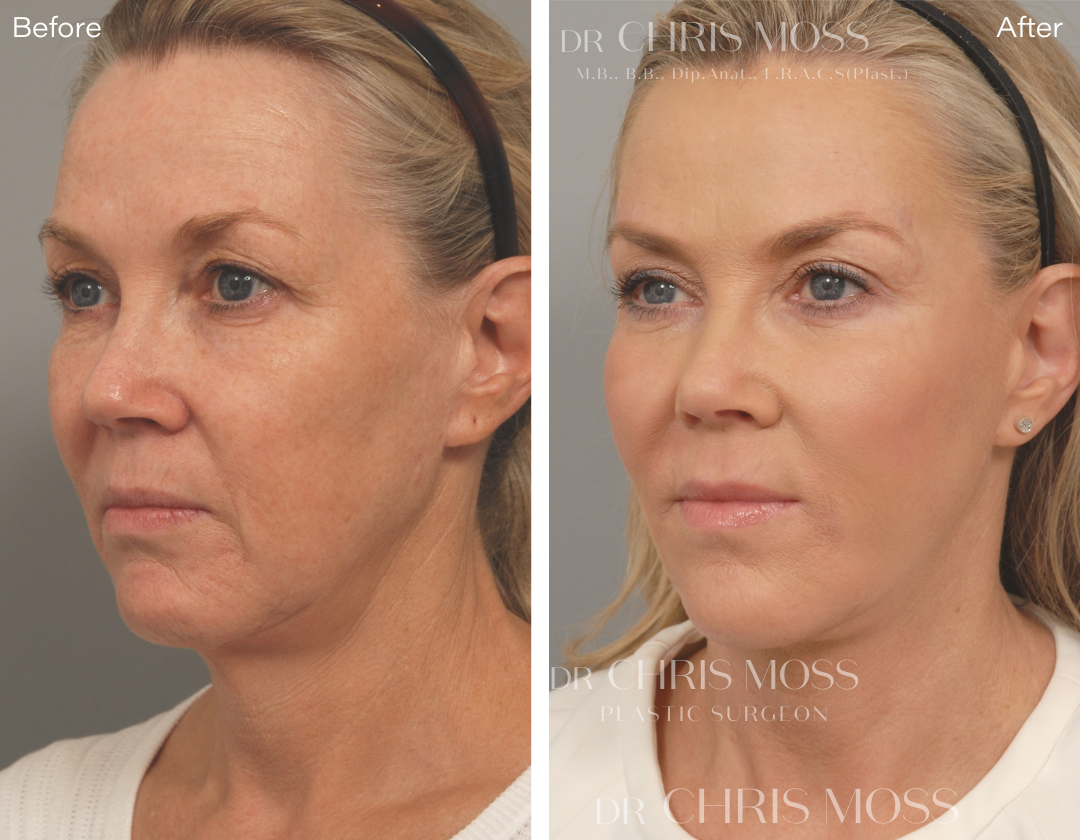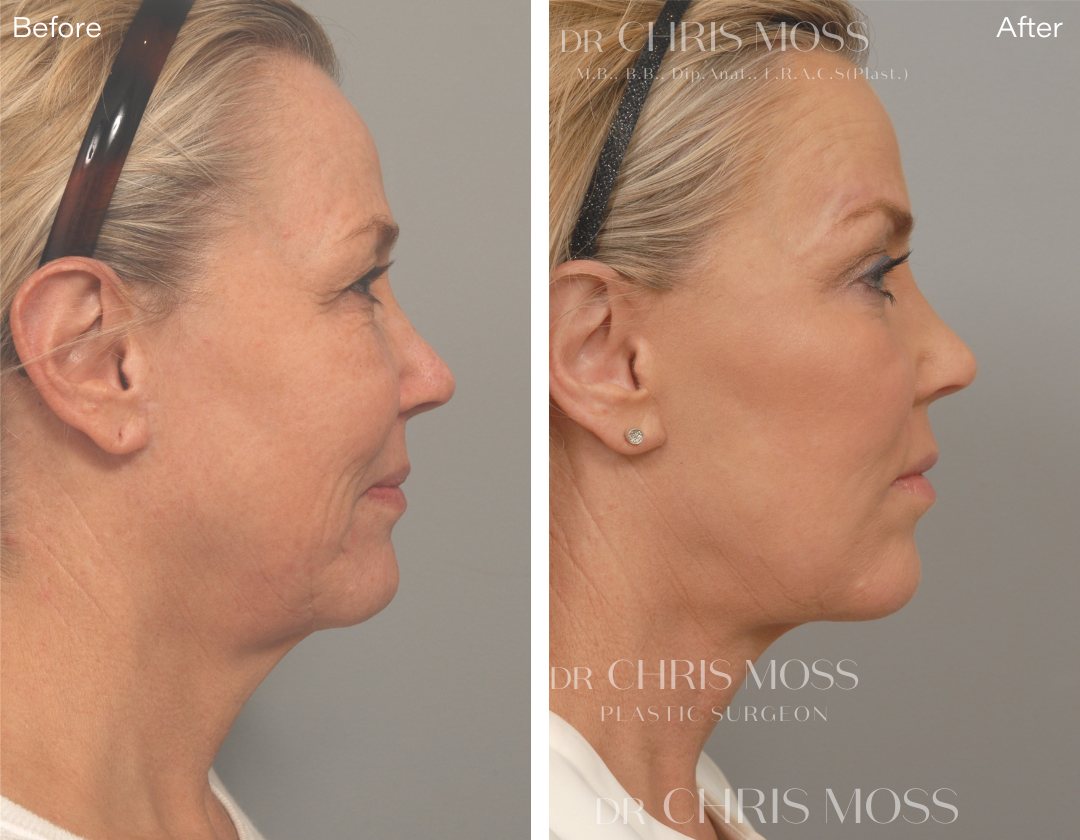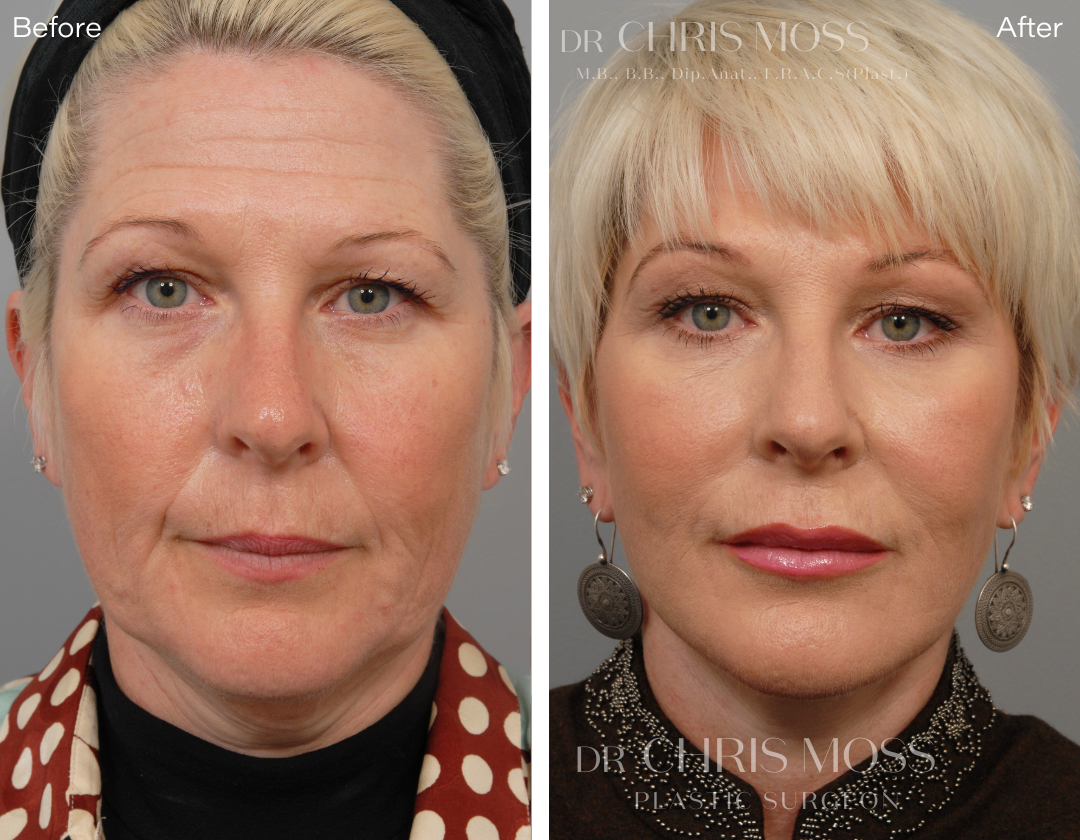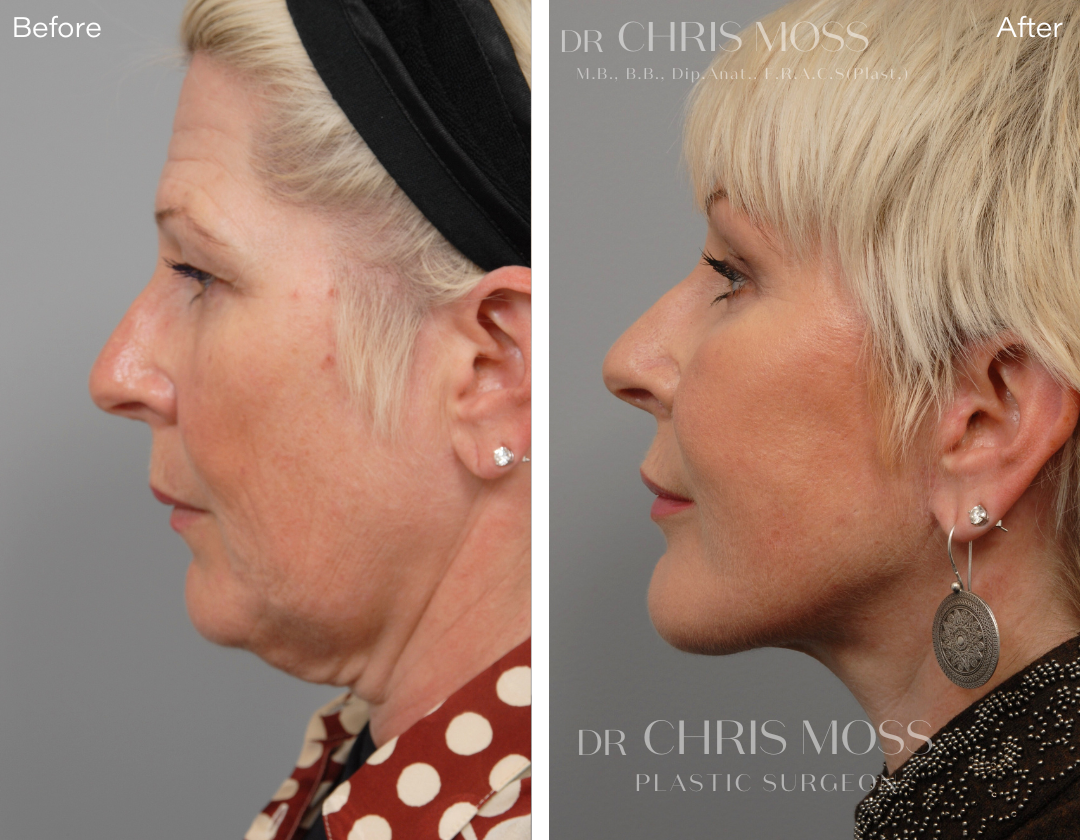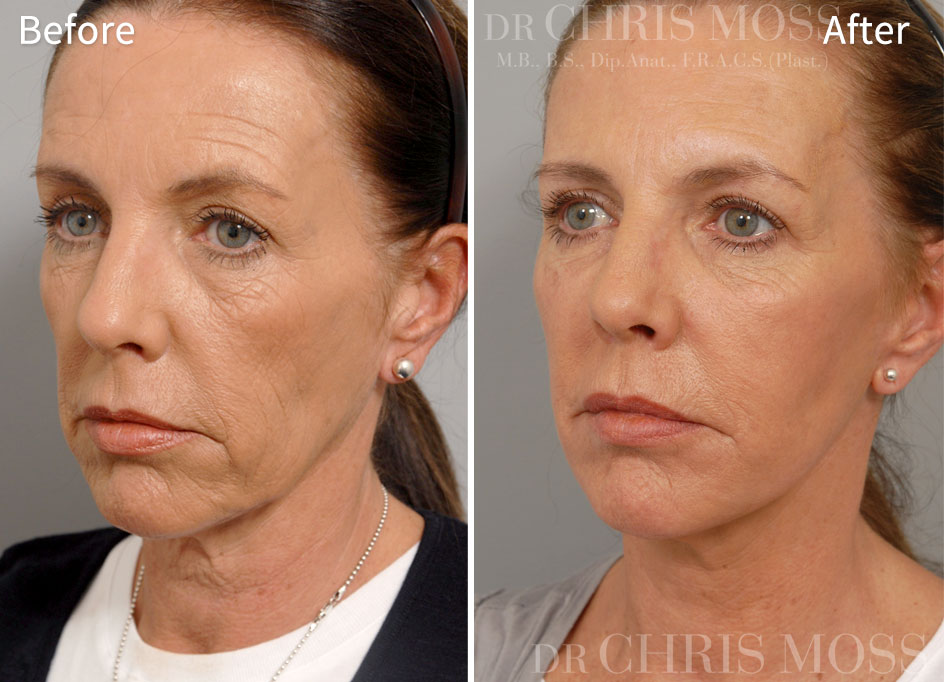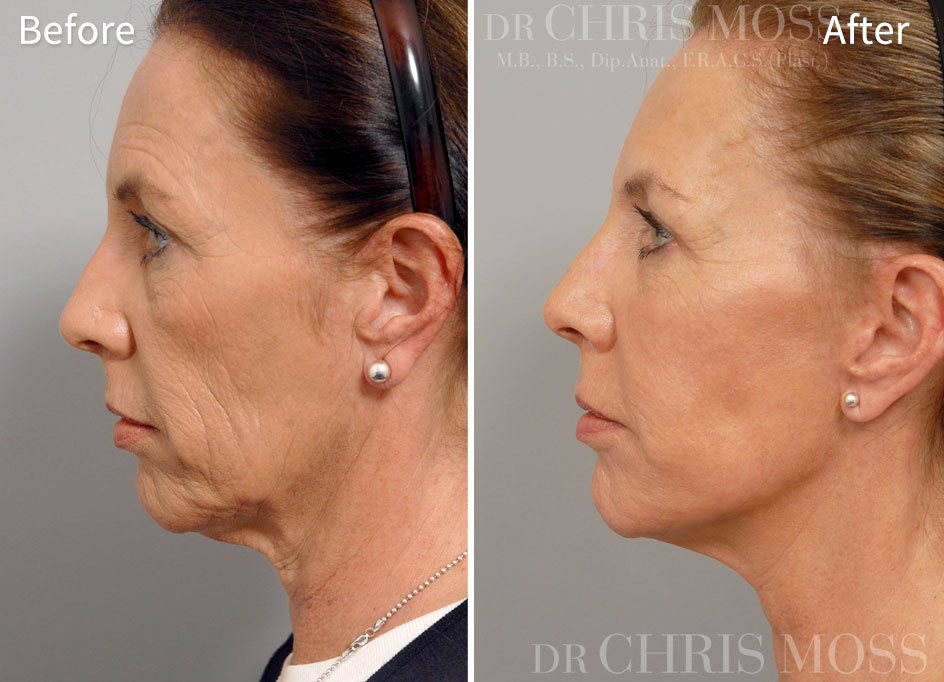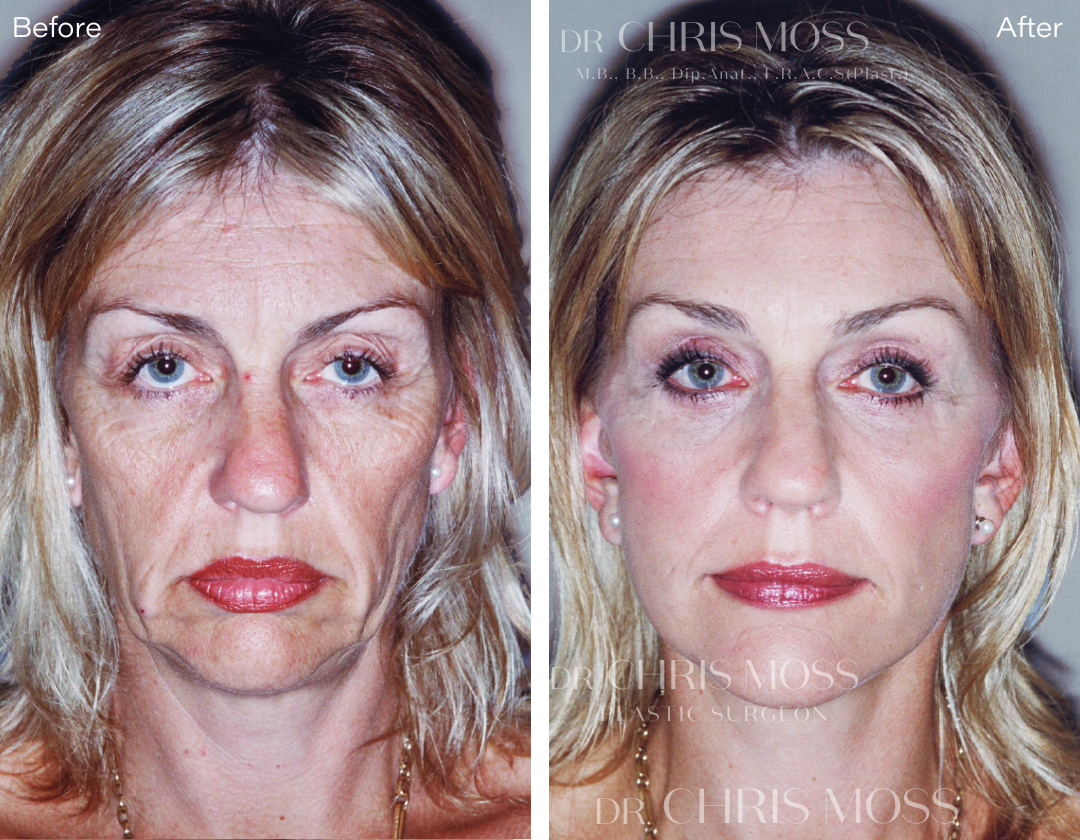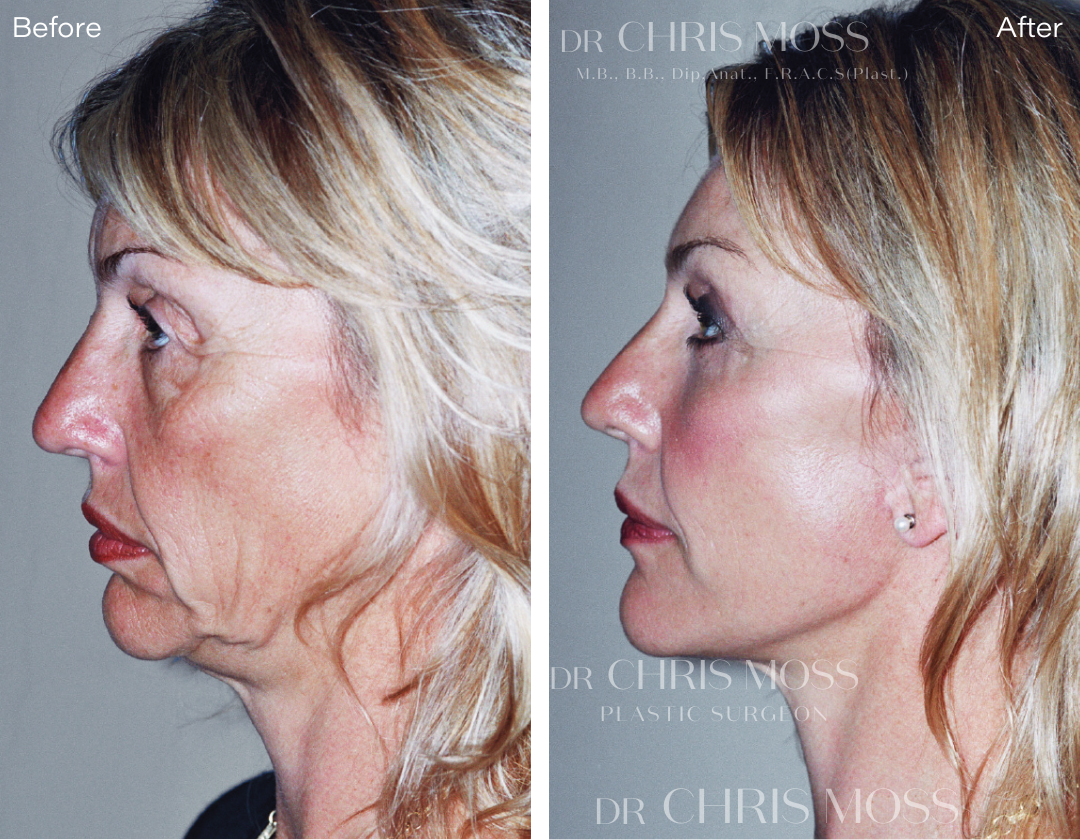Facelift Surgery by Dr Chris Moss
“The aim of a quality Facelift is to improve appearance with measured removal of ageing concerns, while preserving the desirable and natural character of each individual’s face.”

Facelift Surgery Options
During your consultation with Dr Moss he will listen to your aims from surgery, thoroughly assess your face and skin and work with you to devise a customised surgical plan that suits each individual patient. While Dr Moss has trained in and performed all the main techniques of facelift currently available, the actual facelift technique and degree of correction to be performed for each of his individual patients is carefully customised and calibrated in accordance with their personal goals. The technique that he recommends for most facelift patients is the High SMAS Facelift with Lateral Neck Lift –as his philosophy is that the main priority is an optimal result and the operated or displeasing look must be strictly avoided. The High SMAS Facelift technique requires special surgical training and experience for its performance, and not many surgeons in Australia are currently able to offer this High SMAS Facelift approach.
- High SMAS Facelift with lateral neck lift: uses lasting deep layer (SMAS) support to benefit the cheeks and face.
- Limited Incision High SMAS Facelift: uses lasting deep layer (SMAS) support via a limited incision to benefit the lower two thirds of the face and upper neck.
Disclaimer: Results vary from person to person. These images are indicative only and reflect the results for this patient. All surgery involves risks & recovery period – see below.
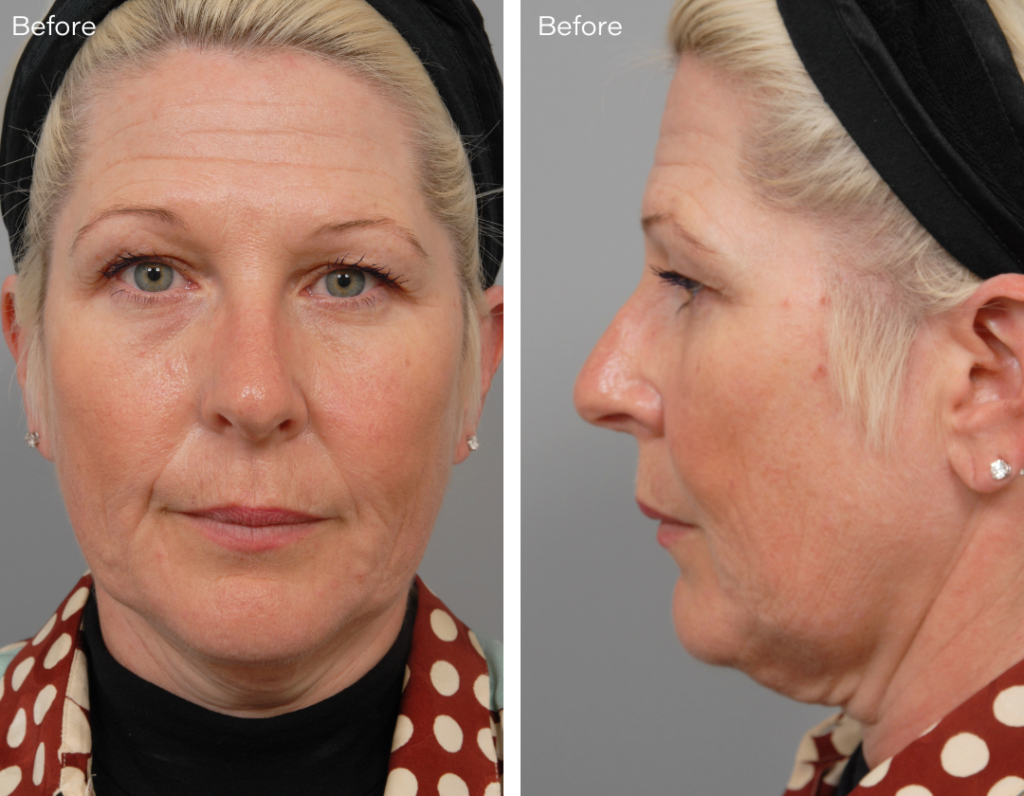
BEFORE
Areas of Concern for Treatment
- Improved shape & skin tone concerns in cheeks, jawline, jowls & neck
- Descent of outer eyebrows
- Left cheek contour deformity from horse riding injury
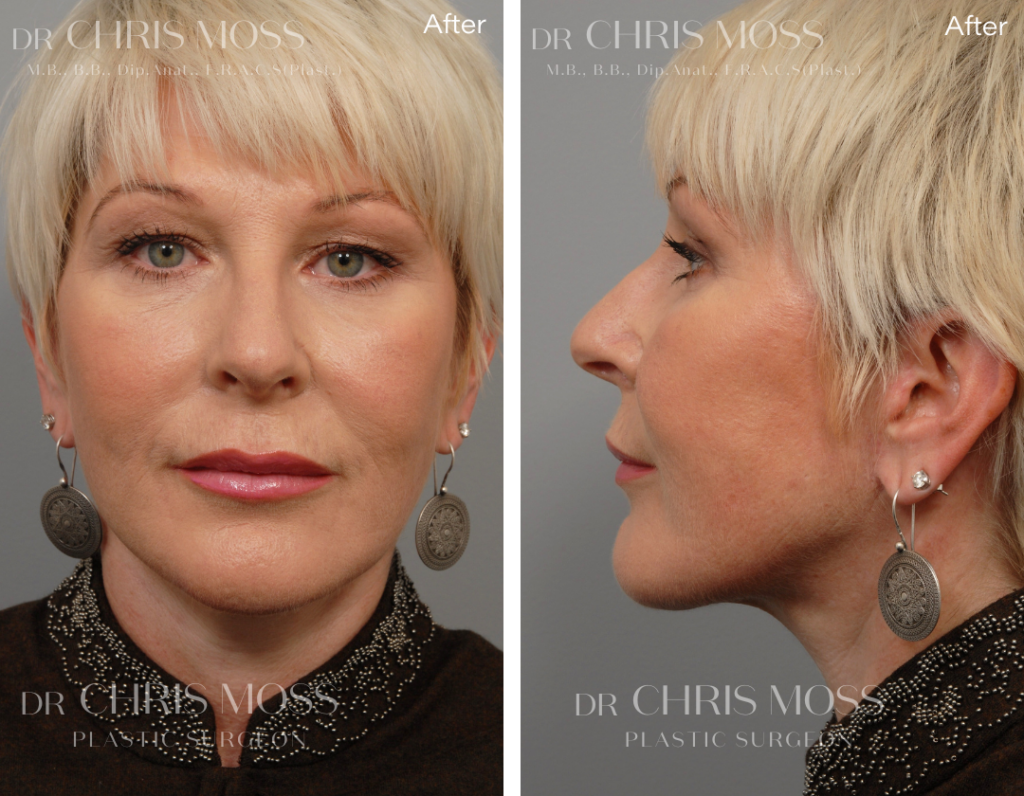
AFTER
Surgery performed
- High SMAS Facelift
- Lateral (side of) Neck Lift
- Submental (front of) Neck Lift
- Vertical Outer Eyebrow & Temporal Lift
- Micro Fat Injections to cheeks, jawline & upper eye area
No eyelid surgery was performed.
The surgical result shown in the ‘After’ image addressed the listed Areas of Concern for Treatment.
High SMAS Facelift with Lateral Neck Lift
A High SMAS Facelift aims to lift and smooth concerning signs of ageing in the face and neck that arise due to excessive loose or descended skin and deep facial tissues. In keeping with Dr Moss’ philosophy, this facelift technique is designed to effectively provide calibrated rejuvenation benefits while also working to avoid the operated or pulled look and excessively visible surgical scars. The High SMAS design provides long-lasting deep plane (SMAS) support in the face, jawline and neck. Unlike many other SMAS technique designs, the High SMAS approach also enables a level of repositioning and support to be performed in a balanced way across the whole cheek and mid-cheek which is considered a significant advantage. In addition to the greater extent of treatment that the High SMAS technique enables, this technique also incorporates and uses all the deep support (beneath the SMAS layer) provided by the surgical manoeuvres recently branded as a Deep Plane Facelift.
The High SMAS Facelift with Lateral Neck Lift can be extended if requested by adding a Mid-Face Lift via the same incision for benefits in the nose-lip folds (nasolabial folds) and loose skin at the sides of the mouth area. Because the lift and support is provided at the deep plane layer, there is no need for any excess pulling on the skin as in old fashioned ‘skin pulling facelifts’, therefore as a routine the healing is better and the scars are finer. By design, the surgical incisions are placed along the folds at the front of the ears and along or within the hairline behind the ears. Effectively concealed scars are not socially detectable so benefits are routinely not recognisable by others as being the result of surgery.
The High SMAS Facelift is designed to deliver comprehensive deep plane support benefits and therefore involves slightly longer surgical time. However, when ageing changes are more advanced, the benefits are usually longer lasting and more natural looking than when outdated and over-tightening skin only facelifts are performed.
For an easy to read High SMAS Facelift information booklet, please contact the Melbourne office.
What is the best age for a High SMAS Facelift?
There is no single best age for a face and lateral neck lift however in Dr Moss’ practice this technique is most commonly performed on those in their forties to sixties.
Who are candidates for a High SMAS Facelift with Lateral Neck Lift?
This can be an appropriate procedure for patients who have more advanced skin excess and laxity in both the and the neck. Excess loose skin in the neck presents as folds of skin under the jawline and extending towards the front of the neck, Excess laxity in the face presents as loose jowls, loosening of previously firm or defined jawline, and descent of the cheeks.
What are other options for achieving results?
Additional surgical options in the area include Submental Neck Lift Surgery, which is sometimes called an Anterior Neck Lift or Front of Neck Lift. The Submental Neck Lift offered by Dr Moss can provide reduction of ageing concerns such as excessive deep fatty tissue under the chin, loose skin under the chin, and vertical tight platysma neck muscle cords. Dermal filler or micro-fat grafting injections are an option to add volume to and help partly smooth out concerning furrows of the face where volume has depleted with ageing. Such fat grafting injections can provide substantial benefits in addition to those offered by a facelift – particularly concerns in regards nose-lip furrows (naso-labial folds), marionette furrows below the corners of the mouth (labio-mental folds) and grooves or volume loss in the cheeks.
Disclaimer: Results vary from person to person. These images are indicative only and reflect the results for this patient. All surgery involves risks & recovery period – see below.
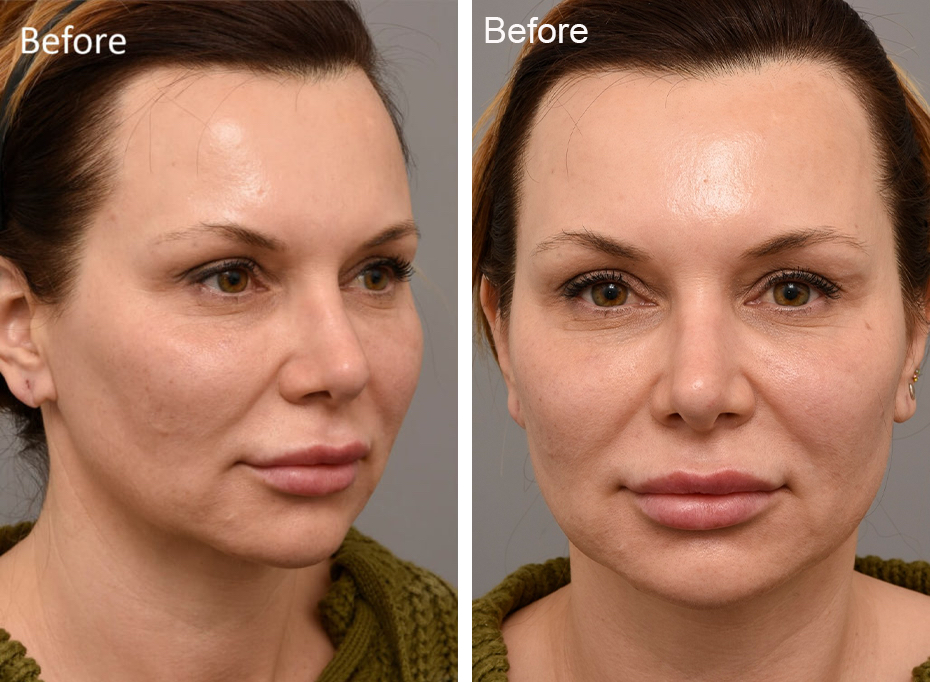
BEFORE
Areas of Concern for Treatment
- Skin tone & shape in the cheeks, jawline & jowls.
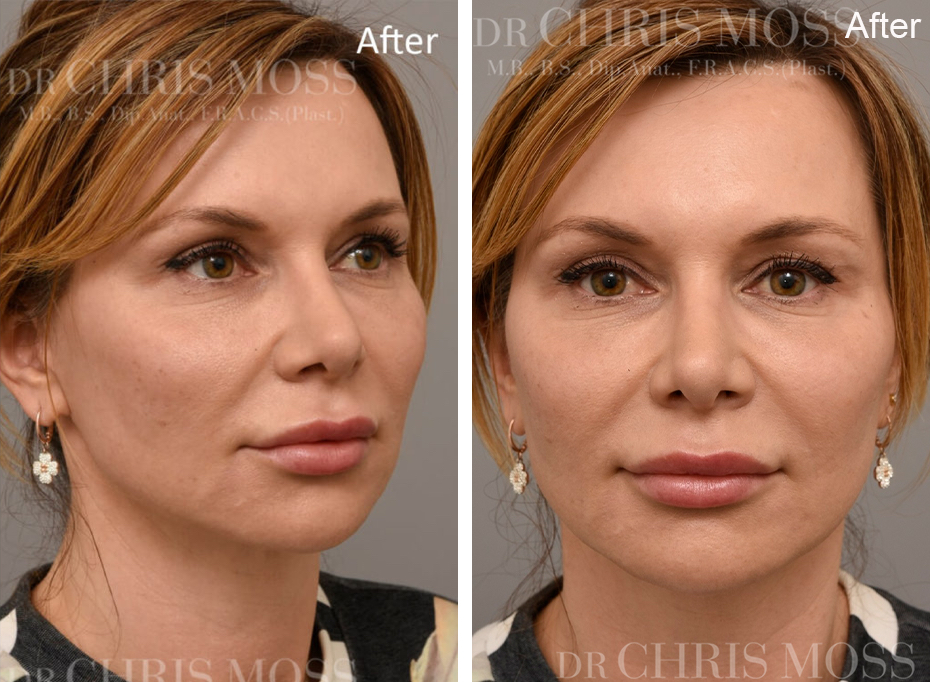
AFTER
Surgery performed
- Limited Incision High SMAS Face & Mid-Face Lift
The surgical result shown in the ‘After’ image addressed the listed Areas of Concern for Treatment.
Limited Incision High SMAS Facelift
The Limited Incision High SMAS Facelift is usually recommended as best for those with facial ageing concerns limited to the lower two-thirds of the face or for patients who – for personal reasons – request a less involved procedure. This is also a High SMAS technique designed to provide long lasting deep plane (SMAS) support in the face and jawline, which enables a level of repositioning and support to be performed in a balanced way across the whole cheek and mid-cheek which is considered a significant advantage. In addition to the greater extent of treatment that the High SMAS technique enables, this technique also incorporates and uses all the deep support (beneath the SMAS layer) provided by the surgical manoeuvres recently branded as a Deep Plane Facelift. The Limited Incision High SMAS Facelift does not include a Lateral Neck Lift component and therefore involves shorter surgery time, shorter incisions, and less recovery than a High SMAS Facelift with Lateral Neck Lift. Therefore costs and hospital stay time are lower. The Limited Incision High SMAS Facelift is designed to provide benefits in the face, however it does not involve surgery or comprehensive correction of more advanced ageing concerns in the neck. For the reasons described above, the surgical scars are routinely fine and designed to blend into the contours in the front of the ear and within the sideburn hair and the procedure is performed with no need for incisions behind the ears. Since there are no scars behind the ears, patients often express that this gives them a confidence that benefits will not be detectable as the result of surgery and allows them to wear their hair up or in a pony tail. For this reason The Limited Incision Technique is also described as a Ponytail Lift, Jowl Lift or ‘Short Scar’ Facelift.
The Limited Incision High SMAS Facelift can be extended if requested by adding a Mid-Face Lift via the same incision for benefits in the nose-lip folds (nasolabial folds) and loose skin at the sides of the mouth area. Because the lift and support is provided at the deep plane layer, there is no need for any excess pulling on the skin as in old fashioned ‘skin pulling facelifts’, therefore as a routine the healing is better and the scars are finer.
For an easy to read booklet on Dr Chris Moss’ Limited Incision High SMAS Facelift, please contact the Melbourne office.
What is the best age for a Limited Incision High SMAS Facelift?
There is no single best age for a facelift however in Dr Moss’ practice this technique is most commonly performed on those in their forties or fifties.
Who are candidates for a Limited Incision High SMAS Facelift?
This can be an appropriate procedure for patients do not want dramatic changes but express concerns about an excessively square shape in the lower face, prominent jowls or dissatisfaction with jawline or concerns about their jowls or jawline.
What are other options for achieving results?
Alternative or additional surgical options include micro-liposuction of the jowls or neck, chin implant, jawline implant and buccal fat reduction surgery. Dermal filler or micro-fat grafting injections are an option to increase the size or definition of the cheek-bone area if there is a concern that the cheeks are not in balance or proportion with the lower face.
When concerns about significant neck skin excess or laxity are present a Lateral Neck Lift is often also recommended at the same time.
Facelift Results
Disclaimer: Results vary from person to person. These images are indicative only and reflect the results for each patient. All surgery involves risks & recovery period – see below.
Further Information on Facelift Surgery and Recovery
Patients undergoing Facelift Surgery usually stay a night or 2 in hospital, depending on the extent of surgery. Surgery is performed under General Anaesthetic. No dressings are required and most sutures will be removed after 7 days. Occasionally the recovery of patients who have significant neck lift surgery is benefited by wearing a chin strap garment at home for 1-2 few weeks after surgery. You can usually return to work and social life by around 10 days for Limited Incision SMAS Facelift and 10-14 days after SMAS Face and Neck Lift surgery . Routinely patients can start returning to light exercise by 2 weeks but need to refrain from more strenuous activity for 6 weeks.
Risks
All surgery carries some degree of risk – no matter who performs the surgery. When surgery is performed by a trained and experienced plastic surgeon there will be measures and precautions put in place to help lower the risk of complications occurring. If complications do occur and require further treatment or revisional surgery, then a qualified surgeon is trained to manage such complications. During the consultation, Dr Moss will carefully explain the possible risks of your surgery so that you can make an informed decision.
Different patients will heal differently, and have different pain thresholds and will therefore experience different recovery times for different activities The following possible complications – which apply to all surgeons worldwide – are listed to inform you, rather than to alarm you. A number of these risks are rare and have not occurred to date in Dr Moss’ practice. Further details on the level of any risk in your particular circumstances, including the possible impact of any comorbidities you may have, are provided in your consultation.
All patients are likely to experience some temporary discomfort/pain, numbness or altered sensation around the incisions or operated areas; bruising and swelling; skin discolouration; lumpiness, tightness, fatigue, low spirits; and nausea – typically from the anaesthetics or pain killers, which may require treatment.
General risks of surgery include wound infection, haematoma (collection of blood under the skin), abnormal scarring, bleeding from the incisions, allergies or reactions to anaesthetic agents, medications, sutures or topical treatments, delayed healing or separation of wound edges.
Specific Risks of Facelift Surgery include thinning of hair or hair loss around the scars; loss of skin due to impaired blood supply; deformity of an earlobe; damage to deeper structures, nerves or rarely paralysis; new or remaining asymmetry; skin discolouration or capillaries; irregular skin contour; psychological dysfunction or mental illness.
Risks of Anaesthesia include tooth damage; heart attack; pneumonia; blood clot in the leg or lung, and stroke. These are uncommon but could be life threatening.
